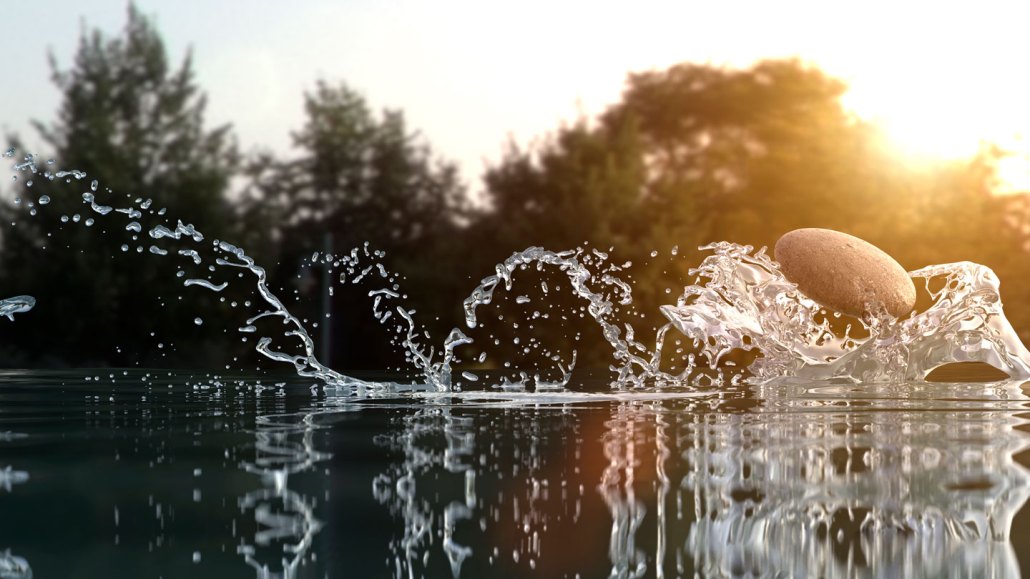Skipping stone physics could aid net-tangled whales and more
Newfound trajectory for spheres in water could improve things from fishing nets to ships

Many children who grow up near bodies of water attempt to fling stones across the water, making them skip as many times as possible before finally sinking. Similar physics inspired the development of new buoys to help save trapped whales.
Colin Anderson Productions pty ltd/Photodisc/Getty Images Plus
Share this:
- Share via email (Opens in new window) Email
- Click to share on Facebook (Opens in new window) Facebook
- Click to share on X (Opens in new window) X
- Click to share on Pinterest (Opens in new window) Pinterest
- Click to share on Reddit (Opens in new window) Reddit
- Share to Google Classroom (Opens in new window) Google Classroom
- Click to print (Opens in new window) Print
Many fishers cast enormous nets into the ocean to catch lots of fish at once. But such mega-nets can nab other species, too — even big ones, such as whales. For instance, in 2017 off U.S. coasts alone, fishing nets trapped nearly 100 whales. Now, physics similar to that of skipping stones could help better save such trapped mammals.
Large fishing nets have been equipped with floating buoys that sense when the net has trapped a whale. But those buoys experience a lot of drag, or water resistance, as a whale pulls them through the ocean. This makes the whale buoys skip across the sea — somewhat like a smooth stone tossed across the surface of a pond. That movement can boost the stress of a trapped whale. It also can plunge buoys into the water, where they stop sending out signals that help rescuers locate the whale.
In a new study, researchers took a closer look at that skipping stone–like behavior in buoys. This allowed them to better understand how drag affects objects in the water. What they learned helped them design a whale buoy with less bobbing. Their insights might one day be useful in ship design and fishing, too.
The group reported its findings July 11 in Physics of Fluids.
Understanding drag
Tadd Truscott is a mechanical engineer at King Abdullah University of Science and Technology. That’s in Thuwal, Saudi Arabia. To investigate whale buoys’ movement, his team watched as small, floating buoy-like spheres scuttled along the water’s surface.
For their experiments, the researchers connected a hollow, aluminum sphere to a string. Then they threw it into a long tank filled with water. With the help of a pulley drawing on the string, they dragged the sphere across the tank. Cameras captured its motion in detail.
Truscott expected a pulled sphere to rise out of the water. Instead, pulling a sphere made it dip below the surface. “I was completely shocked,” Truscott says. Even when pulled along from a high angle, a sphere dipped fully underwater.

Another surprise was that a bubble of air formed around the sphere as it moved under the water. And that bubble greatly affected how and where the sphere moved.
Bubbles can create drag, which can make it harder for an object to move through water. “But this study and other studies we’ve done show that sometimes that’s not true,” Truscott says. In this case, the bubble stabilized the sphere.
The bubble around a moving sphere develops a streamlined, wing-shape. This shape, Truscott says, allows the sphere to experience far less drag than if it did not have the cushioning bubble of air.
The air bubble “suppresses the underwater ‘bouncing’ behavior,” explains mechanical engineer Jesse Belden. Although not a part of this project, he too has studied the skipping behavior of spheres on water. Belden works at the Naval Undersea Warfare Center in Newport, R.I.
Applying the findings
Truscott’s team has now designed a better whale buoy based on what the group learned about how these devices move through water. Since their study showed that a spherical buoy will dive under the water, they worked to create a shape that would keep an antenna from submerging.
The new buoy is “shaped much more like a ship,” Truscott says. That design change means it won’t dive under the water’s surface like spheres do. “The redesign also pierces waves much better,” he adds. Both of those features help buoys stay above water, where they can send out signals to whale-rescue teams.
“If we’re going to keep trying to save whales and other species in the ocean from fishing nets — but not stop fishing — then we’re going to [need] devices like the [new one] we designed for the whales,” Truscott says.

Findings by his team could also be useful for people who design ships, Belden says. Ships tend to burn lots of fuel as they plow through the water, and the more drag they face, the more fuel they use. Cutting drag would lower fuel costs — and ships’ impact on climate change by reducing how much fuel they burn.
Truscott’s team hopes to study how the effects seen here might even apply to other things that move through the water, such as anchors and fishing lures.
“There are all kinds of really interesting fishing devices out there that are probably not very efficient and certainly not designed to move out of the way when a large object like a whale passes through them,” Truscott says. “That’s something that not a lot of people are spending their time on. But certainly,” he says, “we will go down those roads.”







